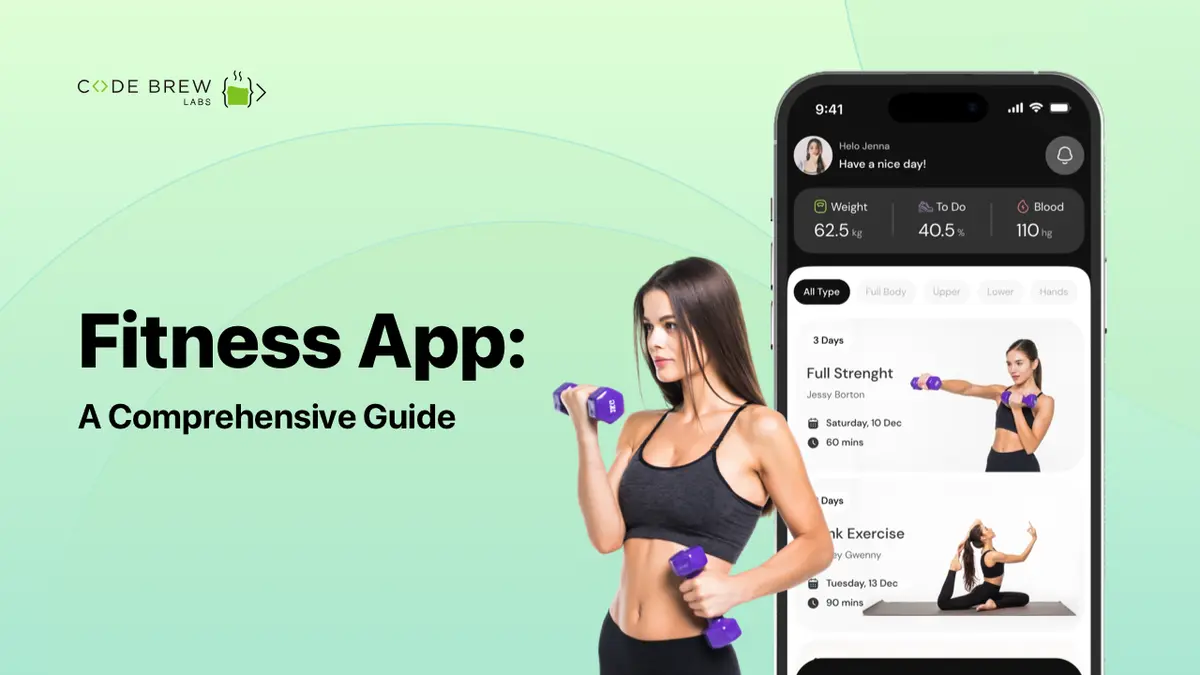
The Age of Information has brought with it a lot of ease to access knowledge. But not without a cost; deteriorating physical and mental health of the working class people–who comprise the majority–on account of sitting for hours together in front of a computer screen, for most days of the week.
Table of Content
Over time, this way of work has led to a rise in chronic health problems like diabetes, obesity, heart issues, etc. And mental health problems like anxiety and depression have become comorbidities with these ailments.
Such a scenario is enough to make the use of the fitness consultation app the new normal. So much so that today, better health is not just a choice but the only option.
Even Statista findings indicate that the user bases of paid and free fitness apps have risen since 2017 and are expected to follow the trend by 2027, reaching 970 million active users.
Essentially, a fitness app works as a goal-oriented and resultative, long-term supportive fitness partner of the user. Fitness apps help users monitor their health and fitness using diverse tracking mechanisms.
Specifically designed for those who want to lead a healthy lifestyle, these apps help users analyze and improve their workout patterns and eating habits.
And as is evident from the introduction above, the demand for a fitness app is constantly growing. So, the time is ideal to launch your fitness app.
Building a robust fitness app is a smart business decision for many reasons:
For starters, there is significant revenue potential: the global fitness app market is expected to reach $19.33 billion by 2029.
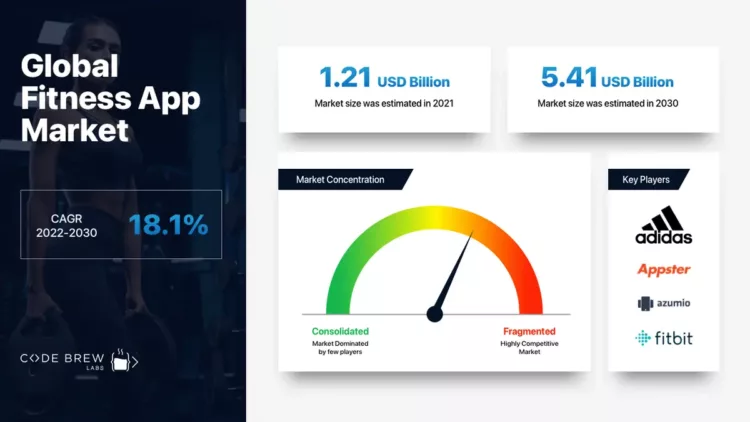
As already mentioned, the fitness industry is growing exponentially, with more and more people looking to improve their health and wellness. Thus, there is a peaking demand for fitness apps providing users with easy access to nutrition advice, activity tracking, and workout plans.
A plus point: this rising demand for versatile fitness app types keeps the niche open for new propositions, making it easier for you to enter the industry.
Regular fitness app users tend to stick with it and recommend it to others. This, eventually, leads to a growing user base.
Also, there’s a misconception that the fitness app audience is only limited to people who used to go to the gym before the pandemic. But these apps are also greatly used by people who are hesitant to visit offline facilities for personal reasons.
A feature-rich fitness app built on a strong wireframe and having a seamless UI differentiates your business from competitors and gives you a competitive edge.
Yes, the pool of competitor apps is huge, but so is the research potential. An intelligent approach to competitor analysis will reveal what users are still seeking in the existing apps. Accordingly, you build a product-market fit.
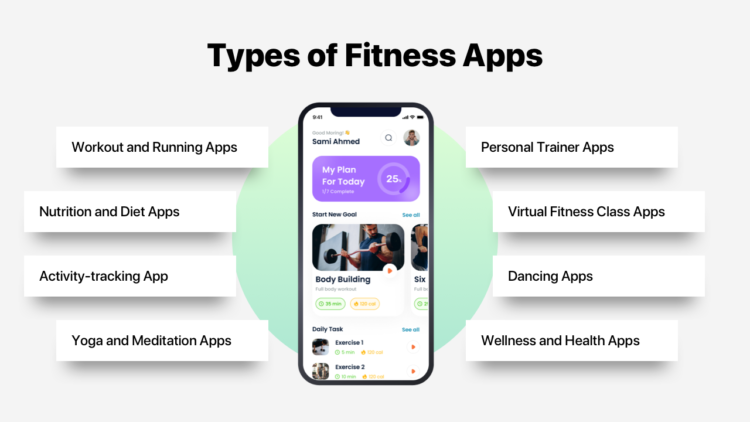
Workout trackers help users keep track of their exercise routine by monitoring the type of exercise, intensity, and duration.
Further, these apps also suggest personalized workout plans, healthy eating tips and tricks, etc. to keep users motivated and on track.
You can build this app for users who want to change their eating habits. By offering them guidance from professional nutrition experts, you can assist people with managing weight and changing their lifestyles for the best.
Do include a visualized diet chart, in-built progress and calorie intake tracker, and cooking recipes.
Typically, these apps include convenient scheduling tools and interactive features to improve user engagement. They have progress-tracking tools and are integrated with popular payment gateways.
To further enhance the app functionality, also add the LIVE video streaming feature and provide users with access to their stats.
On these apps, experts teach mindfulness, relaxation, and flexibility exercises. This significantly helps users improve their mental and physical well-being.
Replete with guided yoga sessions, breathing techniques, and meditation exercises, these apps cater to all types of users. They can even customize their exercise routine to maintain consistency.
Through these apps, users can monitor their daily exercise and wellness routines. These apps leverage smartphone sensors and wearable devices to collect data on activities like walking, cycling, and running.
This type of fitness app offers valuable insights like distance covered, calories burned, and progress charts to motivate users to adopt healthy habits.
These are multi-functional fitness apps that include the definitive features of all the app types mentioned above.
So, these apps may include LIVE video lessons on exercise techniques along with information on well-balanced diets. But know that such apps are generally way more expensive to build.
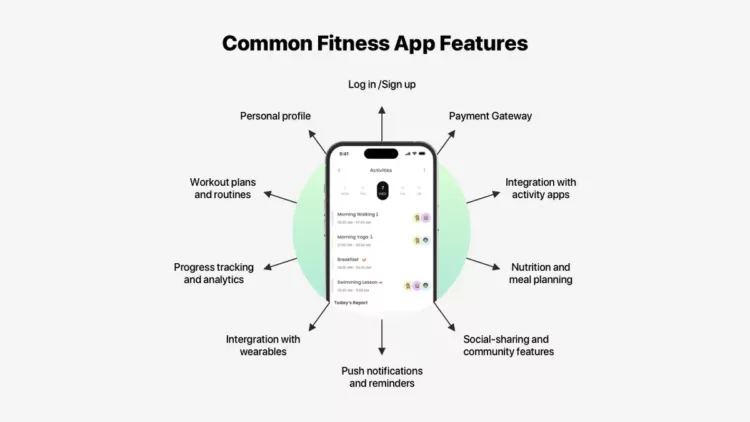
Every type of fitness app requires a specific set of features. Regardless, these are the basic features recommended for every kind of fitness app.
Users should be able to register easily, in a streamlined manner. Add the option of social media integration along with adding fields like name, phone number, and email address in the registration form.
Users need to add necessary details like age, gender, weight, height, etc. It helps the fitness/diet coaches to understand their fitness requirements and accordingly, recommend plans.
It is essential to make sure that the goals of the businesses can be achieved easily. If the users can not achieve their goals then the app is of no use to them. Hence, it is best to include tutorials, activities, and live sessions that can help them in achieving goals.
This is a basic feature that helps track various aspects like sleep hours, steps, pulse, arterial tension, and so on. No external devices are used to keep track of these body parameters.
Gamification elements like badges and rewards don’t just attract users but also help retain them. But make sure that these elements are offered to users in a way that makes them work consistently towards their goals.
Users need to get notified in real-time about new additions that can help them grow, fitness-wise. You can also send them alerts about pending payments, new subscription plans, referrals, etc.
As stated previously, social media integration is crucial for easy user registration. This can be done for Twitter, Facebook, and Google Plus.
Another major feature of the fitness app is user account personalization. After all, who wouldn’t love getting customized features suited to their fitness goals? The personalized tasks can include setting daily or hourly goals with the desired deadline.
There is no doubt that AI, AR, and VR are taking over the industry and that wearable technology is becoming a new trend. Wearables like bands and watches are a great way to track activities in real-time.
The data tracked using these devices is synchronized with a fitness app, which analyzes it to provide more relevant recommendations.
Users should have the option to pay through various modes–UPI, debit/credit cards, and even ‘Buy Now, Pay Later’ schemes.
Add the auto-debit/autopay feature wherein after users avail of free fitness services for a specific time, the payment gets debited as and when it is due.
The Admin needs to have access to all customer data in order to keep up with the user’s needs. Besides, this data can be used to improve the app’s features and achieve better results from all marketing efforts.
The well-trained algorithms can help generate individual dieting options, training paths, and lifestyle suggestions based on previous activity, affinities, and success stories.
The choice of a tech stack depends on various factors, including the number and type of features, platforms (web, mobile) used, the preferred testing and deployment tools, and the programming language used.
However, below are some general suggestions for a tech stack that you may consider:
| Features | Tools |
| Push Notification | Push.io & Twilio |
| Data Management | DataStax |
| Phone Verification, Voice, & SMS | Twilio & Nexmo |
| Payment Gateways | eWallets, Stripe, PayPal, Square, Authorize.net, &
Braintree |
| Database | Postgress, HBase, MongoDB, MailChimp Integration,
MySQL, & Cassandra |
| Cloud Environment | AWS & Microsoft SQL |
| Wearable Integration | Jawbone, Apple-watch, Garmin, & Fitbit |
| Real-time Analysis | IBM, Cisco, Apache Flink, BigData, Spark, & Hadoop |
| Programming Language | Java, Android Studio for AndroidSwift, Xcode for iOS |
| Location & Analytics | Geofence, Google API, and Google Analytics & Webmaster |
| Backend Development | PHP & Laravel |
| Step Tracker | Jawbone UP, Exist API, & Strava |
| SaaS & Email Solution | ZOHO, SaaS API, & SendinBlue |
If you want to know how to build a fitness app, follow through all these stages in the order mentioned below:
Stage 1: Idea Validation
Before you get to building your fitness app, make sure that you validate your MVP. This means doing market research, identifying the target audience, and knowing who your competitors are and what they’re doing.
Make a list of:
These answers will help you develop a unique value proposition and build an app that truly meets the audience’s needs.
Also, define your app’s core features and functionalities and create a business plan. And when you build an MVP, ensure that you first launch the most valuable features to test them before deep diving into full-scale development.
Stage 2: Designing the Wireframe
The next stage involves designing the User Interface and eventually, creating a seamless user experience. Create wireframes, develop a visual design, and map out the overall user journey.
Identify the key features you want to include–progress tracking, workout plans, nutrition advice, and social sharing, to name a few. Add these in the first mockups. It’ll help detect user flow inaccuracies before the coding begins.
Stage 3: Development
This phase involves coding the app’s front end and back end while integrating APIs and SDKs. Here, you need to choose the relevant technology stack (already mentioned above) for the app.
Stage 4: Testing for Bugs and Glitches
Then, you test the fitness app to ensure that it’s working properly and is user-friendly. Test for bugs and performance issues that are impeding the customer experience.
Stage 5: Launching the App
Then comes the launch stage, which involves publishing it on the app stores. Just a heads up: you’ll first need to ensure that it meets the platforms’ guidelines and requirements.
Stage 6: Marketing Your Product
After launching the app, you need to market it to your target audience. After all, if they don’t know about it in the first place, how will they use it? The process involves optimizing the app store listings, curating a marketing strategy, and using several marketing channels to promote your app.
Stage 7: Maintenance and Support
Finally, you need to consistently maintain and update the app throughout the product’s lifetime. It involves fixing bugs and issues (pointed out by customers as feedback), adding new features (whenever required), and keeping the app updated and well-aligned with the latest technology and trends.
The greater the number and the better the type of features, the greater the cost, and vice versa. Besides that, here are some stages that impact the cost of developing a fitness application.
A Detailed Cost Overview:
Factors |
Basic |
Mid-Range |
Premium |
| UI/UX | $5,000 – $10,000 | $10,000 – $25,000 | $25,000 – $50,000 |
| Custom App | $10,000 – $30,000 | $30,000 – $70,000 | $70,000 – $150,000 |
| Testing | $2,500 – $5,000 | $5,000 – $10,000 | $10,000 – $20,000 |
| Advertising | $1,000 – $5,000 | $5,000 – $10,000 | $10,000 – $20,000 |
| Project Management | $5,000 – $10,000 | $10,000 – $20,000 | $20,000 – $40,000 |
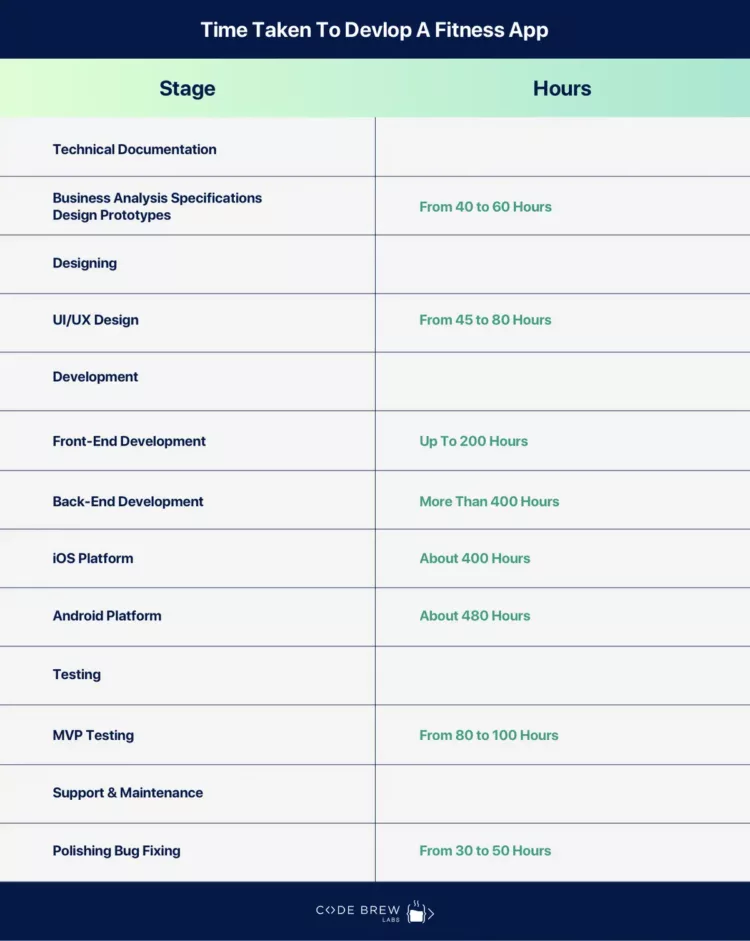
To maximize your profits, you need to have a monetization strategy. There are many ways to devise it but it should be built around your clients’ preferences.
Even while promoting your app as a freemium solution, you can make some features available via in-app purchases. So, the premium version may be ads-free or allow users to get training plans customized to their fitness needs and goals.
When users sign up on your app, it collects their personal information. Use this data to propel them to subscribe to your services. You can even offer your users to pay for a monthly/annual subscription where they get access to exclusive features like advanced tracking tools and detailed reports.
Consider setting up an in-app store to sell sports gadgets and equipment, nutrition products, sportswear, and other similar products that your users might find interesting.
When you provide personalized recommendations to your users that are tailored to their needs, include referral links to online stores. This will allow you to get a percentage of every purchase made through your app.
This type of advertising is one of the most widely-used monetization strategies. You can either integrate your app with popular ad networks or sign a contract with a company.
During the 2022 to 2032 period, fitness apps revenue is projected to grow by 6X to reach a valuation of US$ 8.1 Billion. And, rest assured, there’s a lot of scope for businesses to capitalize on the forecast and impending fitness app market trends.
Besides, Wellness apps–a concept where fitness and technology converge–are spawning a whole new line of businesses. Thanks to their simple functionality, these applications are a great tool for all kinds of fitness enthusiasts: those who do and don’t want to attend the gym or exercise often.
Moreover, considering the ever-growing awareness around health, it’s clear that the health and wellness industry’s future growth will be driven by how customers approach their physical, emotional, and spiritual well-being.
The success of a fitness app primarily depends on one core factor: its ability to deliver a premium user experience. And working with an experienced development team like ours at Code Brew Labs ensures that that happens.
We’re a premium app development company that builds 100% customizable tech solutions meeting the highest quality standards so that your fitness app users get nothing but the best experience. Talk to us to get a quote, or book a consultation.
